Sunday
Community ArticlesShamanic Practice Meets Shambhala Culture
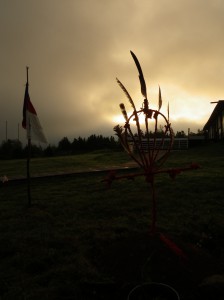 Commemorating Earth Day
Commemorating Earth Day
A conversation between Shambhala Times Editor Sarah Lipton and Leila Bruno, Nancy Sherwood and Patricia Hayward
The 4th Nova Scotia Grandmothers Shamanic Convergence is coming to Dorje Denma Ling September 27-30, 2012. This annual gathering celebrates and explores how shamanic practice can be used for healing individuals, communities and the planet.
Leila Bruno brings us back to the convergence experience… Night has now changed hands with day, the pale evening light silently transforms into the flickering robe of the dark queen: the night. We gather. The fire draws us forward, circling us into a ring. The face and broad hat of the plant medicine shaman flickers in the light of the sacred fire. He is telling a story. His quiet words rise to meet the invisible energy carried upward in the smoke. He tells a story from his life, our lives, and life itself. The spirits dance the story. The fire dances Life.
A late September fog left over from the night before muffles the dawn as I sit on a cushion quietly moving the beads, finishing sadhana practice in the upper shrine room at Dorje Denma Ling. Then two sounds emerging out of the mist wrap into each other. Down below outside on the green, blended human voices chant a Celtic prayer, some old greeting for the sunrise … and up above overhead the lonely calling of an invisible flock of geese flying low under the clouds. There is a soft lingering of something quite real, but nothing lasting….
What if you found out the person sitting on the meditation cushion next to you was a practicing shaman? Would you be surprised? According to Leila, Nancy and Patricia, if you’d been at Dorje Demna Ling last year around the fall equinox attending the Nova Scotia Grandmothers’ Shamanic Convergence, you wouldn’t be.
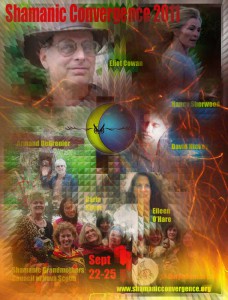 The Shamanic Convergence is an annual community event for those who share the belief that all of life is sacred – including the mountains, ocean and rivers – and that through ceremony and ritual practices, humanity can re-balance its relationship with the earth and all beings.
The Shamanic Convergence is an annual community event for those who share the belief that all of life is sacred – including the mountains, ocean and rivers – and that through ceremony and ritual practices, humanity can re-balance its relationship with the earth and all beings.
Now in its fourth year, the Convergence draws on the practices of different traditions including Dagara of South Africa, Celtic of Ireland, First Nation, Native American, Huichol of Mexico, and Amazon tribes of South America. Within the container of Shambhala society, people journey together with personal and planetary healing and celebration.
The first principle at the Nova Scotia Shamanic Convergence encompasses arriving at the appointed location and co-creating with nature, the elements, the seasons, and with the spirits of the land.
At the center of the Convergence is the Sacred Fire. Burning 24 hours a day for 4 days and nights, Leila explains, we take turns, always tending. The shaman dowses – and waits – to hear where to place the great heart of the community. Balanced between the worlds, perfectly aligned to the four directions, spaced between the sweat lodge and the Earth shrine, it illuminates our path with warmth and brilliance. In this space, exposed to the elements and contained by the energy, we drop our discursive mind chatter, let go our differences and defenses, and come into the presence of our authentic voices, the longings we feel for our life and for our world.
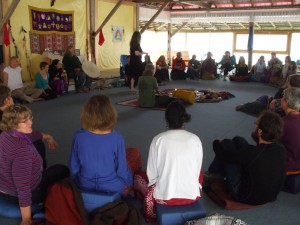 After establishing the heart – the hearth – we set about reconnecting the human community. After being smudged with smoke, Nancy shares, each person offers the water they brought from their home stream, river, lake, or ocean. Then, like mixing the blood of one family, we pour all these together into one container, joining our lives like the waters into one being.
After establishing the heart – the hearth – we set about reconnecting the human community. After being smudged with smoke, Nancy shares, each person offers the water they brought from their home stream, river, lake, or ocean. Then, like mixing the blood of one family, we pour all these together into one container, joining our lives like the waters into one being.
Days later, at the close of the Convergence when the sod from the earth shrine has been replaced back into the basin of the fire pit like pieces of a jigsaw puzzle, we create another ritual for pouring this water over the grass to restore harmony and nourish new growth.
Patricia explains that the sunny days and misty nights of the gathering are filled with mindfulness rituals, ceremonies, nature teachings, silence, story-telling, collective memories, sweat lodges, mandala dancing, chanting, drum journeying, flutes, arts, personal healings, council practice, sharing of intuitions, inspirations, and surrendering the self into the collective.
I ask them, have you ever been curious about the similarity of the two words, “shamanic” and “Shambhala”? Some say these words are related to the Sanskrit term “samadhi” (deep absorption in meditation). Both traditions arise out of ancient roots in healing and magic coming through transmission lineages. Shambhala, with its pre-Buddhist connections to Tibet’s Bon religion comes down into modern times through the lineage of Sakyongs, which mean “earth protectors.”
Leila and Patricia explain that shamanism is one of the oldest tribal healing traditions of indigenous peoples and found in different cultures worldwide. It follows a path of connecting directly with nature because it understands our physical life as both earth-based and contained within a spiritual inheritance that belongs to all beings. Thirty years ago, Chogyam Trungpa Rinpoche wrote about this connection in Sacred Path of the Warrior:
“When human beings lose their connection to nature, to heaven and earth, they do not know how to nurture their environment or how to rule their world – which is saying the same thing. Human beings destroy their own ecology at the same time that they destroy one another. From that perspective, healing our society goes hand and hand with healing our personal, elemental connection with the phenomenal world.”
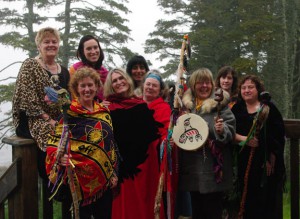 As we speak together, it occurs to us that Shambhala and shamanism share a view of sacred world, both maintaining intention and connection through practice. In indigenous cultures this might come through everyday commonly practiced rituals like singing a song to new seedlings, or following the cycles of the moon in deciding when to harvest a particular fruit. Patricia shares that this is akin to what in the Shambhala approach might be called “bringing down the dralas.” In both cases, practitioners are coming into alignment. They are following paths of mindfully experiencing the senses. In Shambhala we say: “Drala could almost be called an entity. It is not quite on the level of a god or gods, but it is an individual strength that does exist…fundamentally it is connecting the wisdom of your own being with the power of things as they are. If you are able to connect those two things, out of that, you can discover magic in everything.”
As we speak together, it occurs to us that Shambhala and shamanism share a view of sacred world, both maintaining intention and connection through practice. In indigenous cultures this might come through everyday commonly practiced rituals like singing a song to new seedlings, or following the cycles of the moon in deciding when to harvest a particular fruit. Patricia shares that this is akin to what in the Shambhala approach might be called “bringing down the dralas.” In both cases, practitioners are coming into alignment. They are following paths of mindfully experiencing the senses. In Shambhala we say: “Drala could almost be called an entity. It is not quite on the level of a god or gods, but it is an individual strength that does exist…fundamentally it is connecting the wisdom of your own being with the power of things as they are. If you are able to connect those two things, out of that, you can discover magic in everything.”
Along with moments of magic and joy, our time at the Convergence is also penetrated by a broken-heartedness, a sense of how much we long to return to a deep feeling of wholeness – with ourselves, with each other and with the planet. Leila says that when we stay with that yearning in community, something new can and is born out of the space in the center. So we gather and widen into council process and tap into the basic goodness in everyone and everything, relying on a shared belief that any one of the members in the circle could bring forth the needed wisdom of the group.
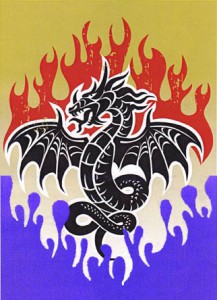 Council practice comes directly out of the wisdom teachings of indigenous cultures. In 2011, Sakyong Mipham Rinpoche said regarding group practice:
Council practice comes directly out of the wisdom teachings of indigenous cultures. In 2011, Sakyong Mipham Rinpoche said regarding group practice:
“The Shambhala teachings emphasize being in society, because at this time we do not have the luxury of isolating ourselves from the world. They teach that true spirituality cannot be isolated in a “spiritual,” or “holy” quadrant of our life. Rather, when we make a fundamental connection with basic goodness, bravery, and lungta [windhorse, life force energy], our entire life can be used as a pathway for awakenment. Shambhala warriorship is a path to social enlightenment. It transcends the path of individual enlightenment and increases our motivation so that we can apply it to the greater social prism….”
Hearing this, we can relax, and appreciate that the wisdom of the ancients has not been lost to the ages but that we can embody this individually and together in our experience of being a good human society here and now.
Reconnecting with our basic human nature IN NATURE has the power to transform our life and society. The 4th Nova Scotia Grandmothers Shamanic Convergence is coming to Dorje Demna Ling September 27-30, 2012, the Year of the Dragon. Be there.

















May 19, 2012
Reply
I’m really touched by this article. I was brought up in the Shambhala community, and have adventured outside the community for many years. I studied with a Mic Mac Shaman for 5 years, and have had other contact with indigenous shamanism – including loving the book, Women Who Run With the Wolves, by Dr. Clarissa Pinkola Estes. I really feel there is an important marriage between Shambhala and shamanism. So I am very happy to read of this program happening. I’d love to come join you!
May 1, 2012
Reply
Thanks! Does one need to be a Grandmother to attend? What is the age bracket for this convergence?
:-)
Apr 30, 2012
Reply
Which are the approach of your philosphy abot art issues?